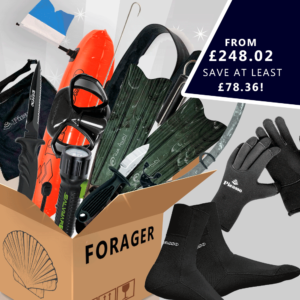With food prices sky-high in this country, it’s no wonder more people than ever before are looking at ways to hunt and gather their own food. Food that is free from the growth hormones, pesticides and antibiotics. Those new to using our coasts as their own personal larder will quickly discover that foraging is an incredibly easy way to fill the table with tasty, high-protein 100% natural food that would otherwise require a second mortgage to buy in Sainsbury’s.
When we talk about foraging on this site, we’re generally talking about going into the shallow water, popping on your fins, mask and snorkelling around, bagging yourself a few delicious lobsters, some mouth-watering scallops or a few succulent crabs. Of course, you can collect yourself a bowl of mussels and a lot more from the beach without venturing into the sea. But if you’re willing to go into the shallow water, there IS a tonne of free food up for grabs along the coastline. Besides lobster etc – there’s razor clams, welts, limpets, oysters, clams, octopus, many crabs including spider crabs (sometimes huge!) and even urchin aka Cornish Kina, you might even decide to grab yourself an armful of seaweed, if that’s your bag.
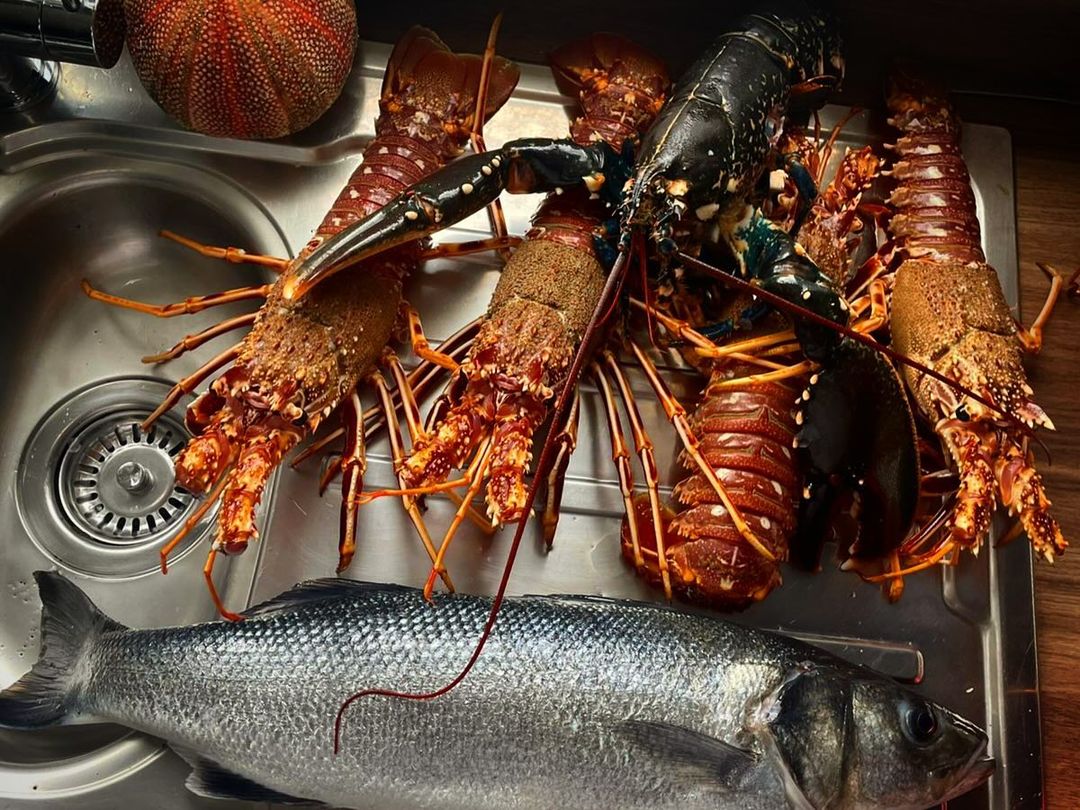
Above: Getting ready for the BBQ with Spearfishing UK team diver Mat Coombe – sea bass, crawfish tails, lobster and Cornish kina.
Besides the obvious appeal of free food, foraging is also a good stepping stone into spearfishing. You’ll be hunting in the shallow waters which is a great way to get used to wearing the kit and being in the ocean. It’s a safe environment to get acclimatised to everything. As your confidence grows, you’ll likely want to start hunting fish too because you WILL see some while you’re out foraging. Spearfishing UK owner Tony shot his biggest bass in less than a metre of water – they just chill in the shallows digesting their last meal or cruise around slow, looking for an easy snack. You honestly don’t need to dive, and in reality you may well even be more productive just quietly snorkelling, stalking the kelp and string weed. Check out Mat Coombe’s Instagram to see videos on how this is done, sometimes it’s so shallow you can pull yourself along!
Anyway, back to the foraging. You can forage during the day in most tidal areas (i.e. along the coastline) and you don’t need a licence. Just avoid any areas that have been designated as Sites of Special Scientific Interest (SSSI), Special Areas of Conservation (SAC), or Marine Conservation Zones (MCZ) – and obviously any zoned-off private beach. Foraging or any type of hunting in these areas is often restricted or regulated to protect wildlife and habitats.
View this post on Instagram
If you’re solely targeting crustaceans (lobsters etc), you can also do this at night. You can’t spearfish at night (since 2019), however. So foraging is a good way to fill the larder when the vis is too bad for a dive, or the fish are just having a shy day.
Your main legal restrictions for foraging relate to size. These are governed by local byelaws or UK Statutory Instruments. In Cornwall, the minimum sizes are:
| Shellfish | Carapace |
| Crawfish | 110mm |
| Edible crab female | 150mm |
| Edible crab male | 160mm |
| Spider crab | 130mm |
| Lobster | 90mm |
If you’re a region other than Cornwall, click here for links to the relevant website and minimum sizes.
What is the “carapace”? It’s the upper section of the creature, so the top part of a lobster, or the width of the crab shell, or just the width of the scallop. With the lobster, you’ll measure from its eye socket to its back. The easiest way to measure is using a lobster gauge, and we sell our own low cost one here.
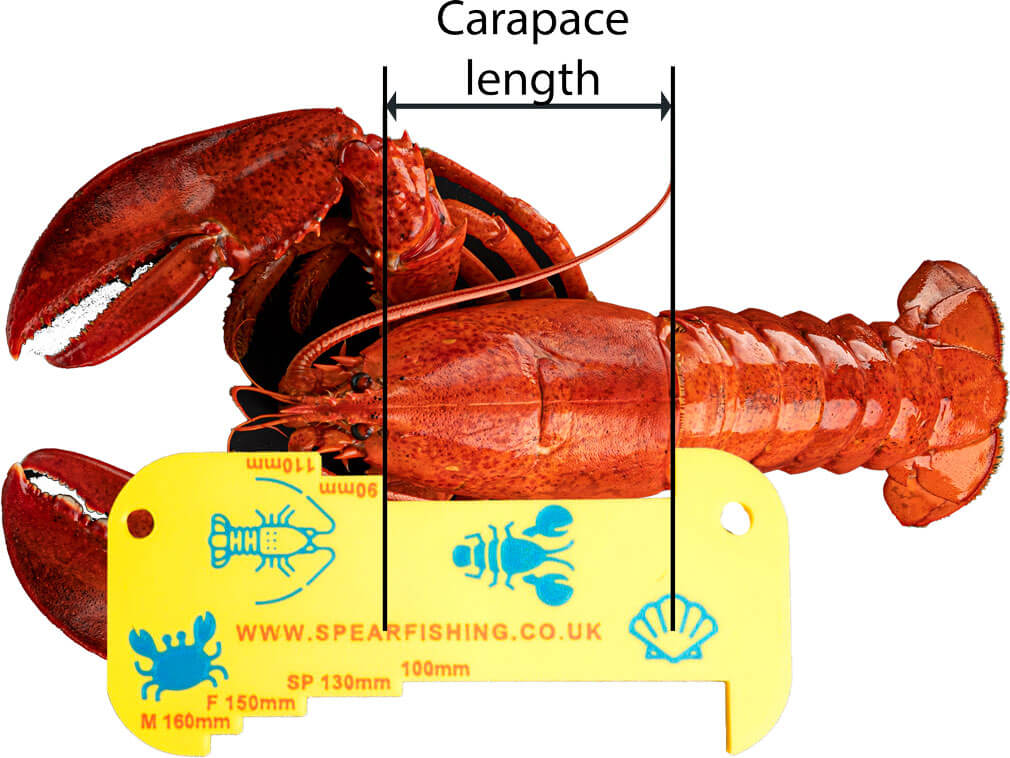
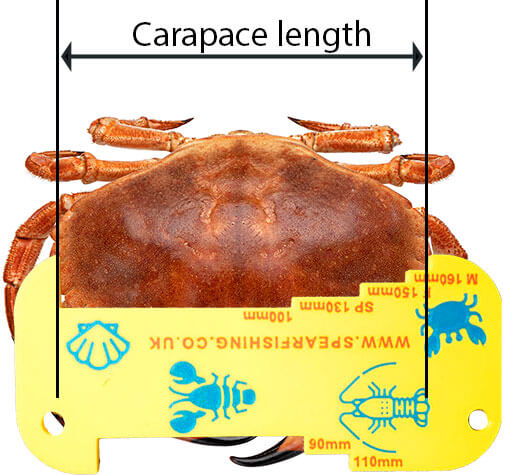
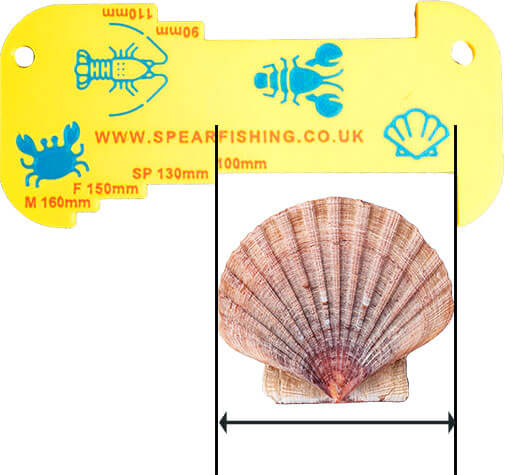
If you find a lobster that has a small ‘V’ cut into its tail flipper, you need to release her back into the ocean. A specific number of females are deliberately “v-notched” to ensure a healthy population continues to be established. The notch clipped into their tail is a clear signal to us lobster hunters that the creature should be returned to the water and it’s an important part of sustainability.
You also have to return berried lobsters or crawfish to the water. This means lobsters or crawfish that are carrying eggs attached to the underside of their tail. Again, as you might imagine, this is just part of sustainability to allow the creatures to keep breeding. Remember that over-harvesting and damaging habitats can lead to stricter regulations and loss of foraging privileges, so it’s in our interests to keep to these rules.
A final point to note is that you also can’t shoot lobsters – you have to catch them by hand. And it probably doesn’t need to be said but lobsters, crabs, crawfish – they can be a bit nippy. This is where a few handy tools come into play.
Foraging tools and equipment:
Lobster snares:
![]()
A lobster snare is a sure-fire way to up your lobster game. You place the snare behind your target, loop its body and then introduce him to your BBQ! As it’s spring-loaded, you can use this little tool single handed. Our team’s top-tip is to avoid snaring the claws as your lobster will just eject them when it realises its caught. Aim for the tail by passing the loop behind the lobster and snaring it from behind.
Remember they have poor eyesight but are very good with their feelers so avoid contact at all costs as it will tip them off to your cunning plan!
Lobster crook
![]()
This nifty tool pins the body of the lobster in place so that it has no escape routes to jettison out to. Overall it gives you more traction to pull the tasty critter out of its hole as it has two points of contact.
Hooks
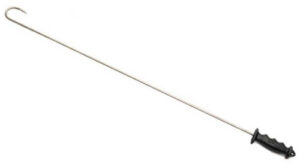
These tools are great for helping you harvest those awkward holed-up shellfish. Save your fingers from those pesky claws and hook them out safely with these handy tools.
Other gear
You’ll need fins, a mask and a snorkel to get yourself far enough into the water to find something decent (don’t worry if you’re new, it’s not too far). They really don’t have to cost a fortune and we have some really affordable brands such as Labrax that can bring the cost down significantly.
A knife or three is also a must for obvious reasons – an oyster shucker will help you open the crustaceans. It’s also an essential safety tool – although it’s immensely rare, it’s possible you could come across some old fishing line and you’d want to be able to cut yourself free.
You’ll also need some foraging bags to store your tasty catch.
Since these creatures love hiding out in dark cracks and holes, a waterproof torch is also important.
Then to keep you toasty while you’re hunting, you’ll want a wetsuit, gloves and socks. You can easily get away with an old surf wetsuit to get you started. It should keep you warm for a good 90 minutes but if you want to stay out longer, a good spearfishing wetsuit will keep you going for 4 – 6 hours.
A belt with weights will make life much easier. All the wetsuit neoprene makes you very buoyant which gets super annoying very quickly when you’re trying to look into holes and cracks just below the water line. Your wetsuit thickness will determine how many will work best, but you can start with 4 – 6kg and go from there.
A catch bag is essential otherwise you have to return to shore each time. Then consider attaching that to a surface buoy – this keeps your hands free when needed, while also keeping you nice and visible to other ocean users, especially boats if you venture out a little further.
Finally, don’t forget your gauge to check your sizing!
We do a foraging package deal which has everything we’d recommend for you to start out. It’s an absolute bargain, saving you about £78 on the regular prices of all these essentials.
Foraging safety:
Foraging and spearfishing in the UK are both extremely safe hobbies. That being said, anything in the ocean must be treated with respect and common sense.
- Never attach anything to your body aside your weight belt and your knife; and don’t attached anything to your belt aside dive weights and maybe a knife.
- Always use a surface marker float so you are visible to other watercraft.
If you’re going to hold your breath while foraging then never hyperventilate: simply relax, dive and then come up when your body tells you. Never try to ‘push through’. If you would like some safe suggestions on where to go for your first forage, feel free to post up on UKSpearfishingBuddies on Facebook or call the shop for some general advice.
As you advance and want to dive deeper for longer, there are other safety considerations that come into play. There is more free information on our website and we also supply courses.
Final tips:
Do check local bylaws before you go and do be sustainable. Take only what you need so that this wonderful free food source isn’t depleted or overly-regulated in the future.

